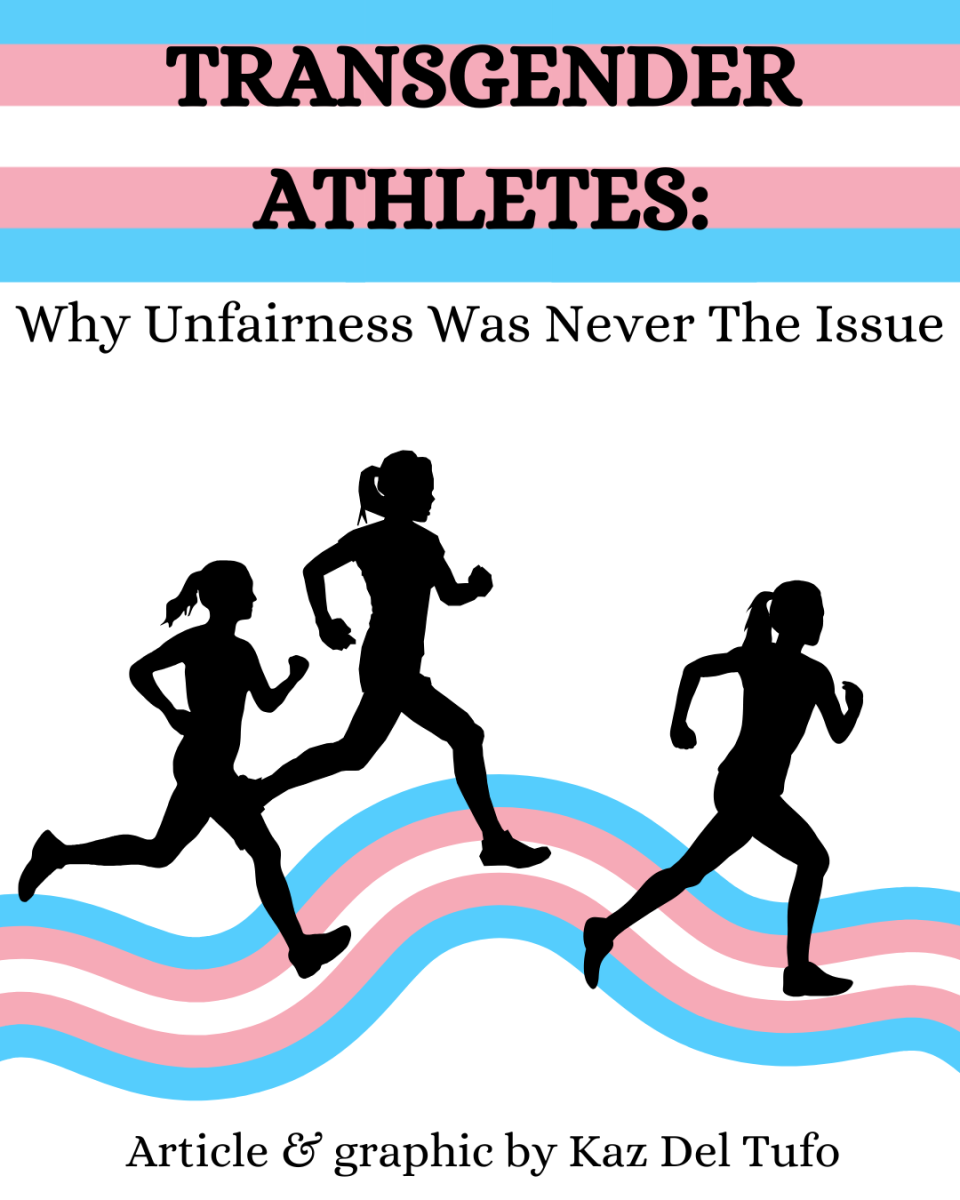With transgender (1) people being brought into the foreground by the numerous executive orders and laws being passed over the last few months, the sports issue is once again becoming a topic of conversation. From transvestigating (2) the Algerian boxer, Imane Khelif, during the 2024 Olympics, to nearly half of the states passing some kind of ban on transgender athletes, much of the buzz around the debate is negative. However, many of the leading arguments against transgender athletes, particularly against transgender women (3), fail to consider the fact that sports are never 100 percent fair because biological advantages are inherent in all forms of it.
The biggest issue most people have with the participation of transgender athletes in sports is that they feel they will have a “biological advantage” over the people, usually cisgender (4) women, that they are playing against. This argument fails to consider the fact that due to biodiversity in humanity, everyone is going to have some kind of advantage or disadvantage. For example, the Olympic swimmer and current champion in terms of gold medals, Michael Phelps, has unusually long arms, incredibly large lungs, flipper-like feet, and his body produces less lactic acid than other people. These attributes combined allow him to reach the finish line faster, propel through the water like a dolphin, and get tired slower. Despite all of these advantages, no one is clamoring to ban him from swimming or revoke his medals. Similarly, Olympic swimmer Katie Ledecky likely also produces less lactic acid, making her an amazing swimmer, yet she receives backlash from people insisting that she must actually be a man because of how excellent she is at her sport. This double standard of insisting that anyone who is particularly good at their sport must be male is not only rooted in misogynistic, but also incredibly transphobic.
Furthermore, some sports, such as archery, have negligible differences in performance between men and women. In the 2024 Olympic Individual Archery event, the first and second place female archers in the ranking round, Lim Sihyeon and Nam Suhyeon, would have beaten the first place male archer, Kim Woojin, if they had been in the same event. Comparing the scores from the finals, Sihyeon also achieved a higher score than Woojin, bringing into light the question of why archery is a separated sport.
While there are sports, such as basketball and rhythmic gymnastics, where one side or the other would have an advantage over their competitors, the same is true of cisgender athletes competing in the same field. While the height for women basketball players averages out to four inches less than men, any person who is 6-foot-10 playing against someone who is 6-foot-3 would be at an inherent advantage, yet these tall players are seen as a commodity in basketball, not unfair or cheating. Biological female competitors in rhythmic gymnastics would perform better than someone who is biologically male, being that they are typically more flexible, shorter, and have a lower center of gravity, however, cisgender female competitors who are taller would also be at a disadvantage compared to their shorter counterparts. People only seem to notice the difference in performance between the genders when men outperform women, or when comparing cisgender and transgender athletes.
The notion of transgender women having a significant advantage over cisgender women in strength fails to acknowledge the way that estrogen (5) affects the body. Studies have noted that transgender women who have been on HRT (6) for 3+ years have significantly decreased muscle mass and performance in athletics, to the point that they are on par, if not slightly better in certain areas than cisgender women. For example, one study noted that after 2 years of HRT, “no advantage was observed for physical performance measured by running time” (Oxford Academic). Many transgender women also choose to use hormone blockers (7), which in turn prevents testosterone (8) from affecting their results by blocking the continued effects of the hormone. The laws that call for transgender women to be on the same team as cisgender men would be putting transgender men (9) in the same leagues as women, despite their advantages retained from testosterone taken during their HRT; yet, the opposition never acknowledge this point, because the goal isn’t fairness, it’s about keeping transgender people as the “other.” If transgender men can’t play with women because of their testosterone advantages, and transgender women can’t play with men due to their disadvantage from estrogen, yet neither can play with people of their actual gender because of laws banning transgender athletes, then the laws are inherently banning transgender people from participating in sports as a whole.
Beyond professional sports, much pushback comes from parents who don’t want their child to play against transgender girls, fearing that they will hurt them while they play. While there is some logical basis for this argument, most female leagues have limited touching and more strict rules on how roughly you can defend against the other players. For example, when comparing youth girls’ soccer teams against youth boys’ soccer teams, the boys are allowed to get away with significantly rougher shoving than the girls. Beyond this, if people play sports expecting to never get hurt at all, they have a very poor understanding of how sports work. Cisgender women and girls playing against other cisgender women and girls are going to get hurt just the same as playing against anyone else, because there is always risk in sports. If people are so put off by rough playing, they can separate leagues by roughness, instead of gender, being that there are plenty of female players who have no issue with playing rough and plenty of male players who would prefer to play more gently.
For an issue that is so commonly brought up at the mention of transgender people, the numbers do not back up the argument. The ways in which transgender athletes are talked about make it seem as though they are a large, dominating force that is slowly taking over sports, one team at a time. In reality, transgender people as a whole make up only about 0.5 percent of the population of the United States (Healthline). Furthermore, of this population, a minute percentage of these people even want to participate in sports, and there are so few professional-level transgender athletes that no studies have been completed on the percentages. Out of 500,000 athletes competing in the 2024 National Collegiate Athletic Association, only 40, or less than 0.008 percent were transgender (Harvard Crimson). Even in high school athletics, where more transgender people are more likely to compete, negligible numbers have been recorded, about 4 per state. Many transgender athletes, particularly transgender youth, participate in sports not to hurt women and win all the time, but to find a community of people and build teamwork, the same as any other sports player.
Transgender athletes are not the problem behind women’s sports. The politicians and outspoken people who constantly raise this issue are using it as a scapegoat for their own mistreatment of women in sports. Lawmakers are hiding the real issues women are facing in sports behind headlines about transgender athletes destroying their competition to cover their own backs. In general, women’s sports receive about half of the funding that men’s sports get, and despite the passage of Title IX (10) to prevent discrimination, “92.7 percent of college and university athletic departments are out of compliance” (American Public University). Even as children, boys are encouraged to pursue sports, while girls are told they aren’t good enough, or will never be as good as boys. Transgender athletes are not the problem in women’s sports; it is, like most women’s issues, the fault of the men who make the decisions around it.
While the discussion around transgender people in sports is very sensitive, it is important to understand that transgender athletes are people. They are the same as any other athlete, and their aim is not to deliberately hurt women. Many opponents of transgender athletes fail to consider all aspects of being transgender, not just the biological makeup before transition. Sports will always have aspects that benefit certain groups and disadvantage others based on body composition, but transgender participation is not the cause; it’s merely human diversity.
Glossary
transgender: someone whose assigned sex at birth and gender identity are not aligned
transvestigating: portmanteau of transgender and investigation; refers to the practice of attempting to identify certain features of people in order to determine if they are transgender
transgender women: a woman who is assigned male at birth and transitions socially and/or medically to better reflect their female gender identity
cisgender: someone whose assigned sex at birth and gender identity are aligned.
i.e cisgender woman: born female and identify as female
estrogen: the hormone that is typically naturally occurring in cisgender females; used in HRT for transgender women undergoing medical transition and for cisgender women undergoing menopause
HRT: hormone replacement therapy, a process in which someone takes hormones in order to substitute missing hormones, or in the case of transgender individuals, replace the preexisting hormones
hormone blockers: used to pause the production of hormones, pausing puberty for adolescents and allowing adults to prevent features of their assigned sex from surfacing post HRT
testosterone: the hormone that is typically naturally occuring in cisgender males; used in HRT for transgender men undergoing medical transition
transgender men: a man who is assigned female at birth and transitions socially and/or medically to better reflect their male gender identity
Title IX: a law protecting against sex-based discrimination in education programs or activities that receive federal funding; it states “No person in the United States shall, on the basis of sex, be excluded from participation in, be denied the benefits of, or be subjected to discrimination under any education program or activity receiving Federal financial assistance.” (U.S department of Education)
Citations
Cheung, Ada, et al. Impact of Gender-Affirming Hormone Therapy on Physical Performance | The Journal of Clinical Endocrinology & Metabolism | Oxford Academic, 13 July 2023, academic.oup.com/jcem/article/109/2/e455/7223439.
Hodshire, Soren. “Is It Common to Be Transgender?” Healthline, Healthline Media, 27 Aug. 2024, www.healthline.com/health/transgender/how-common-is-transgender#quick-stats.
Crimson Editorial Board. “There Are Many Obstacles Facing Women’s Sports. transgender Athletes Aren’t One.” The Harvard Crimson, 16 Apr. 2024, www.thecrimson.com/article/2024/4/16/editorial-obstacles-trans-womens-sports/.
Jacobs, Brittany. “Is There Gender Discrimination in Sports? How to Fix It.” APU, 31 Jan. 2024, www.apu.apus.edu/area-of-study/nursing-and-health-sciences/resources/is-there-gender-discrimination-in-sports/.
U.S Department of Education. “Title IX and Sex Discrimination.” U.S. Department of Education, 2021, www.ed.gov/laws-and-policy/civil-rights-laws/sex-discrimination/Title-IX-and-Sex-Discrimination.








